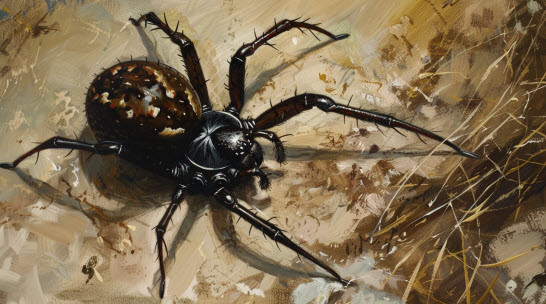Due to their potentially dangerous bites, false widow spiders have gained notoriety in recent years. They are one of the few spider species in the UK that can bite humans, and their venom can cause a range of symptoms from mild discomfort to severe illness. However, despite their fearsome reputation, these spiders are fascinating creatures that play an important role in the ecosystem. This article will explore all aspects of this spider, including its physical characteristics, habitat, diet, venom, and medical implications. We will also delve into preventative measures and treatment options for those who may come into contact with these spiders.
Table of Contents
Introduction
When it comes to spiders, most people tend to think of creepy, crawly creatures that scare them to bits. One spider in particular that has been getting a lot of attention – and not in a good way – is the False Widow Spider. In this article, we’ll dive into the world of these infamous arachnids to learn more about what they are, how to identify them, where they live, and what they eat.
What are False Widow Spiders?
They are a group of spider species that resemble the infamous Black Widow Spider. These spiders belong to the Steatoda genus and are found in various parts of the world. While they are not as venomous as their Black Widow cousins, False Widows can still pose a threat to humans due to their venomous bite.
History
The false widow first made its appearance in the United Kingdom in the late 1800s, likely arriving on ships from its native Madeira and the Canary Islands. Since then, these spiders have spread throughout the UK and have even been found in other parts of Europe and North America.
Physical Characteristics and Identification:
The appearance of False Widow Spiders
These spiders are small to medium-sized spiders with a round, bulbous abdomen and a shiny, dark brown colouration. They have eight legs and two front pedipalps that resemble an extra set of legs. These spiders also have a distinct body pattern resembling a skull or hourglass.
How to Identify False Widow Spiders
To identify the spider, look for the distinct skull or hourglass-shaped marking on its abdomen. This marking is usually a creamy white or yellow colour, located towards the back of the spider’s abdomen. False Widow Spiders also have a round, bulbous abdomen and a shiny, dark brown colouration.
Distribution and Habitat:
Global Distribution
False widow spiders can be found in various parts of the world, including Europe, Africa, North America, and South America. They are particularly common in the UK, where they have been steadily spreading for decades.
Preferred Habitat of False Widows
False widow spiders prefer to live in warm, dry areas such as sheds, garages, and other outbuildings. They can also be found in walls, crevices, and other hidden spaces. These spiders are not typically found in homes unless they have easy access to an outdoor area.
Diet and Prey:
Types of Prey Consumed by False Widow Spiders
False widow spiders are carnivores and feed on a variety of insects, including flies, moths, and beetles. They also eat other spiders and can even take down prey that is larger than themselves.
Feeding Habits
The spiders are active hunters and use their silk webs to trap prey. Once they have caught their prey, they inject them with venom and consume them. These spiders have a high metabolism and need to eat frequently to survive.
Venom and Medical Implications:
Types of Venom Produced by False Widow Spiders
The venom produced by false widow spiders is a neurotoxin. It affects the nervous system of its prey and causes symptoms such as paralysis and muscle weakness. The venom contains various compounds, such as latrotoxins and phospholipases. The latrotoxins cause the release of neurotransmitters, while the phospholipases break down cell membranes. These compounds can cause severe damage to the nervous system and other organs.
Medical Implications of a False Widow Spider Bite
While spider bites are rare, they can cause severe symptoms, including localized pain, redness, and swelling. In severe cases, the venom can cause systemic symptoms, such as fever, nausea, and muscle cramps. Rarely, the bite can cause anaphylaxis, a severe allergic reaction that can be life-threatening.
If you suspect a false widow spider has bitten you, seek medical attention immediately. Your doctor may administer antivenom to counteract the venom’s effects and manage your symptoms.
False Widow Spider Bites: Symptoms and Treatment:
Symptoms of a False Widow Spider Bite
The symptoms of a false widow spider bite can vary depending on the individual’s sensitivity and the amount of venom injected. The most common symptoms include:
– Localized pain and swelling
– Redness and warmth around the bite
– A mild fever
– Nausea and vomiting
– Muscle cramps and spasms
The symptoms can progress to life-threatening conditions such as anaphylaxis or shock in severe cases.
Treatment for a False Widow Bite
If a false widow spider has bitten you, the doctor may administer antivenom to counteract the venom’s effects and manage your symptoms. Over-the-counter pain relievers and antihistamines can also help manage localized symptoms such as pain and swelling.
Prevention and Control measures:
Preventative Measures to Avoid These Spiders
The best way to avoid these spiders is to take preventative measures to eliminate their habitat. This includes:
– Keep your home and garden free of clutter and debris.
– Seal cracks and gaps in your home’s foundation and windows.
– Keep your garden well-maintained and free of overgrown vegetation.
– Store firewood and other materials off the ground and away from your home.
Ways to Control False Widow Spider Populations
If you have an infestation, consider using insecticides or hiring a pest control professional to help eliminate the population. Make sure to follow all safety guidelines when using insecticides and keep them out of reach of children and pets.
Conclusion and Future Research Opportunities:
Summary
False widow spiders are a type of venomous spider that can cause severe symptoms if they bite. While bites are rare, taking preventative measures to avoid infestations and seeking medical attention immediately if you suspect you have been bitten is essential.
Possible Future Research Opportunities
Future research on false widow spiders could focus on developing more effective antivenom to counteract the venom’s effects and reduce the risk of bites. Additionally, researchers could explore the spider’s habitat and behaviour to understand better how to control populations and prevent infestations. In conclusion, this spider is an intriguing and misunderstood species that has caused concern among people. While their bites can be painful and potentially dangerous, it’s essential to remember that these spiders are also valuable members of the ecosystem. By understanding more about their behaviour, habitat, and venom, we can better appreciate and coexist with these fascinating arachnids.
Frequently Asked Questions
Are all spiders with a brown body and creamy markings false widows?
No, not all spiders with brown bodies and creamy markings are false widows. False widow spiders have a distinctive marking on their abdomens, which looks like a skull or hourglass.
What should I do if one of these spiders bites me?
You should seek medical attention immediately if a false widow spider bites you. While most bites are not serious, some people may experience an allergic reaction or other severe symptoms.
Are the spiders aggressive toward humans?
No, false widow spiders are not aggressive toward humans. They are shy and will usually retreat if they feel threatened. Bites usually occur when a spider is cornered or accidentally pressed against the skin.
Can these spiders be kept as pets?
While false widow spiders can be kept as pets, it is not recommended for inexperienced pet owners. These spiders require a specific environment and diet, and their venom can be dangerous. It is best to consult with an expert before attempting to keep false widow spiders as pets.
Contact Us if you need something else.




















